Movie Review By: SFAM
Year: 1997
Directed by: Luc Besson
Written by: Luc Besson & Robert Mark Kamen
IMDB Reference
Degree of Cyberpunk Visuals: High
Correlation to Cyberpunk Themes: Low
Key Cast Members:
Korben Dallas: Bruce Willis
Leeloo: Milla Jovovich
Jean-Baptiste Emanuel Zorg: Gary Oldman
Father Vito Cornelius: Ian Holm
Ruby Rhod: Chris Tucker
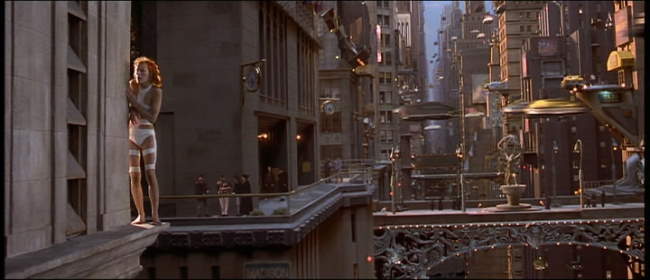
Overview: Some movies are just absolute absurd fun – so fun that you end up watching it endlessly. The Fifth Element is that way for me, and is a movie I’ve seen around 20 times or so. The tone of the movie is too light-hearted to be considered a real cyberpunk movie, but like Tank Girl, we can consider this a cyberpunk comedy. The characters are all a hoot, and the movie never takes itself seriously – in fact it’s almost always over the top. Many of the cyberpunk themes still exist in Fifth Element, although, again, they are enacted in a light-hearted way. It’s the visuals that really bring Fifth Element into the cyberpunk subgenre.
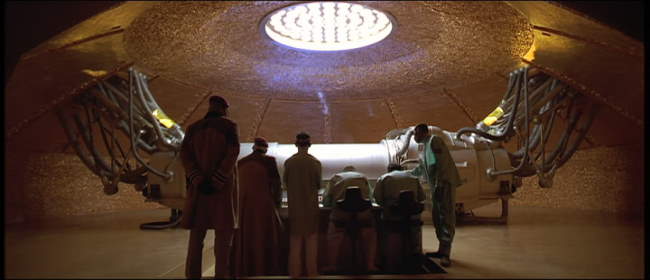
The Story: 217 years into the future, ultimate evil is again coming to destroy the earth. Ultimate evil takes the form of an absolutely massive malevolent ball of blackness that is on a course to destroy earth. Every attack the Federated Territories try only makes it larger. It turns out that a group of priests has been keeping the ancient technology necessary to destroy ultimate evil – four stones representing the 4 elements, which surround a fifth element. In this case, the fifth element is s beautiful girl (Milla Jovovich), reconstructed from the remains of a small DNA sample.
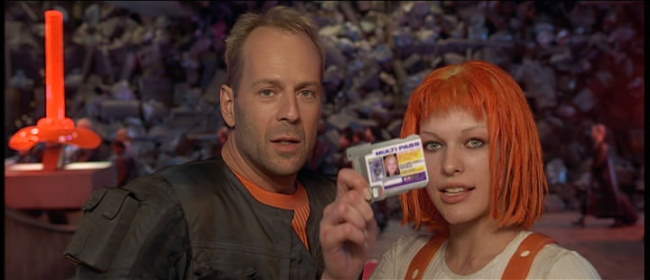
“Leeloo Dallas, Multi Pass”
Korben Dallas (Bruce Willis) is a down and out highly decorated former military commando, now turned failing cabbie, who has a beautiful girl named Leeloo (Jovovich) fall into her cab – literally! The authorities are after her, as it turns out she has escaped those who recreated her. She can’t speak English yet she figures a way to ask for help. After she asks, Korben Dallas takes her to the priest, Father Vito Cornelius, who recognizes her as the Fifth Element, and promptly kicks Korben out.
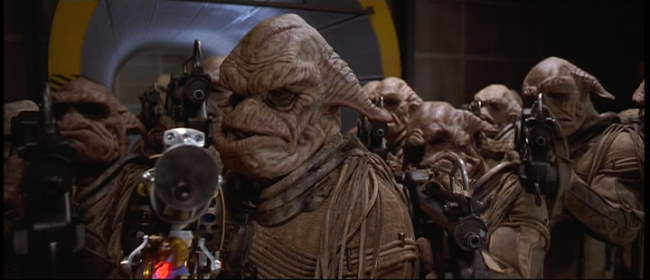
From there, things get crazy. The military approaches Korben for a secret mission to retrieve the stones necessary to stop ultimate evil. The stones are hidden with a famous Diva who is performing at the famous floating hotel, Floston Paradise. At the same time, Zorg, an evil corporate CEO (Gary Oldman) has hired a group of Mangalores (evil, ugly aliens) to retrieve the stones. Simultaneously, Father Vito Cornelius and Leeloo also find a way get to Floston Paradise to retrieve the stones. Things get even weirder when the famous radio host, Ruby Rhod (Chris Tucker), an outrageous guy with a penis-head hairdo hosts the Floston Paradise experience with Korben as his guest!
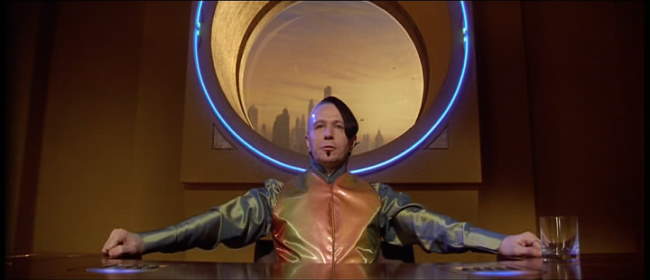
The Acting: All the main characters in the Fifth Element are quirky and memorable. Bruce Willis really works as a former hero, now on his last leg. Jovovich is beautiful and otherworldly. Tucker is a riot! This movie really got him known (Rush Hour made him famous though). And Gary Oldman as Zorg is flat out awesome as a completely crazed power-hungry evil doer with a quirky sense of style and salesmanship. Truly, Besson did a great job in casting this.
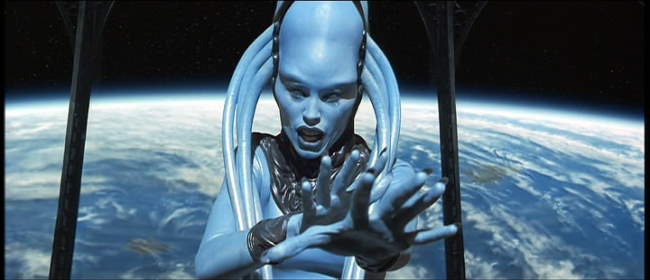
The Visuals: The Fifth Element totally rocks in the cool futuristic visuals department. The colors include dark yellows with neon blues for the backgrounds, saturated blue scenes and orange clothes for the leads. But its the city-scapes, reminiscent of Lang’s Metropolis that are especially memorable. They flat out nail a far out vision of the future. Additionally, we have airports with 30 foot tall trash heaps due to a garbage worker strike, fully automated, ultra-processed McDonalds, deaf rock stars
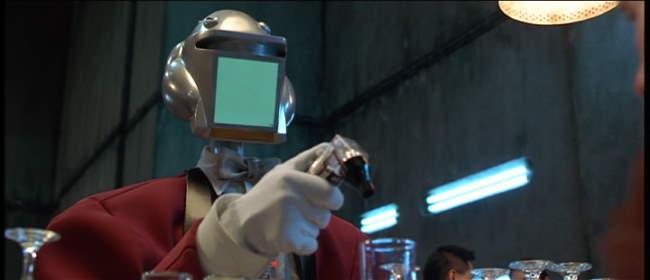
The Editing: The editing in the Fifth Element is just terrific. The splicing of the various story strands, as crazy as they are, flow wonderfully. In discussing the missing stones, the simultaneous, intermixed dialogue between Leeloo and Father Cornelius and Zorg with the Mangalores are just one terrific example of this; the Diva opera singling intermixed with Leeloo’s fighting is another. With the amount of stuff going on here, this could have ended up a disaster. Sylvie Landra, who also edited Leon – the Professional, deserves heaps of praise for this.
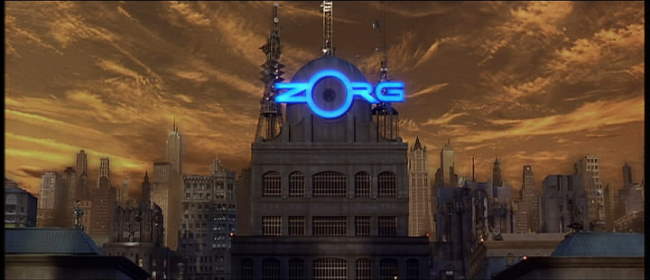
The Fifth Element Cyberpunked Future: Dropping the crazed fantasy aspects of the stones and ultimate evil, The Fifth Element gives us a pretty dire view of the future. Cities are built high to escape the constant layer of smog that coats the surface; corporations are all-powerful; governments are impotent; fashion statements have gone seriously awry; cockroaches are used as intelligence, surveillance and reconnaissance systems - but at least we still get cheap Chinese food! Plus robots now do all our menial work!
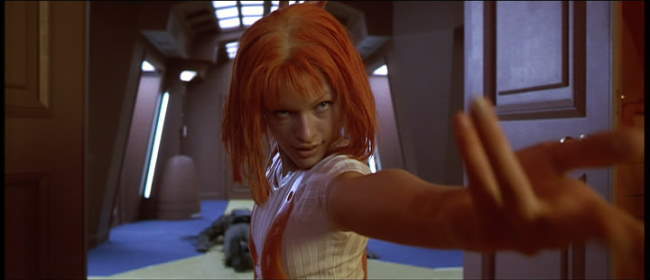
The Bottom Line: No, the Fifth Element is not intended to be taken seriously. Still, this movie is just far more enjoyable than it has any right to be. The action and romance are fun, the characters are unforgettable, the story is entertaining, the music is great, and the visuals are marvelous! The Fifth Element has been in my regular heavy watching rotation since it came out. Give this a watch if you’re looking for a witty futuristic cyberpunk action-comedy flick.
Go to Page 2: More Fifth Element Screencaps–>>
~See movies similar to this one~
Movie Review By: SFAM
Year: 1990
Directed by: Marianne Trench
IMDB Reference
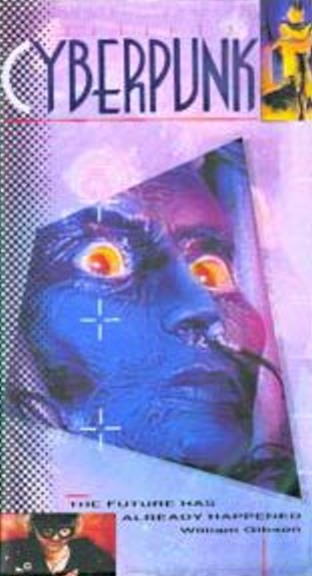
Overview: Cyberpunk is a documentary that looks back at the 80s cyberpunk movement, and more specifically, how this has led to a trend in the “real” world where people were starting to refer to themselves as “cyberpunk.” The documentary sees “cyberpunks” as being synonymous with hackers. A number of writers, artists, musicians and scientists are interviewed to provide context to this movement. The guiding meme, as told by Gibson, is that information “wants” to be free. 60s counter-culture drug philosopher, Timothy Leary, provides a prediction that cyberpunks will “decentralize knowledge,” which will serve to remove power from those “in power” and bring it back to the masses. Many different potential technologies are discussed, including “smart drugs,” sentient machines, advanced prosthetics – all of which serve to give context to the idea of post-humanity and its imminent arrival on the world stage.

As a documentary, Cyberpunk is haphazard. Some of the interviews, such as those by William Gibson and Timothy Leary are interesting, while others are mired in mediocrity. To mitigate the boredom of some of these, the film makers stoop to using cheesy visual effects to increase the interest. In one case, an interviewer is duplicated to four small windows, and in another, the talking head is completely moiréd out except for their eye. In fact, we are barraged by a stream of weird, experimental effects – one imagines that these are supposed to give us the “hacker-cyberpunk mindset” or something. In general, they don’t work, but I’m guessing the late 80s CG graphics probably looked far more futuristic back then.

The Bottom Line: This documentary really almost serves as a time capsule for capturing a still emerging hacker counter-culture. From a cinematic perspective, I’m saddened that Blade Runner was virtually non-existent in this. While they covered books, music (Front Line Assembly was the main one), science and art (Jaron Lanier, who coined the term “Virtual Reality”), their coverage of film was pretty sparse, generally restricted to obscure animes (which looked cyberpunk, but unfortunately I’m not familiar with). I will say I liked the younger William Gibson LOTS more than on his No Maps for These Territories documentary. He talks excitedly about cyberpunk, hackers, and our direction towards post-humananity. Ten years later, Gibson comes off completely bored with these ideas, and almost seems to wish he was never associated with the term, Cyberpunk.
~See movies similar to this one~
Movie Review By: SFAM
Year: 1996
Directed by: Jon Kroll
Written by: Mark Valenti
IMDB Reference
Degree of Cyberpunk Visuals: Low
Correlation to Cyberpunk Themes: Medium
Key Cast Members:
Menno: Bill Campbell
Loria: Stephanie Romanov
Mick Dourif, Rebel Leader: Bruce Campbell
Simon, Menno’s Friend: Michael Dorn
Felix Medina: Corbin Bernsen
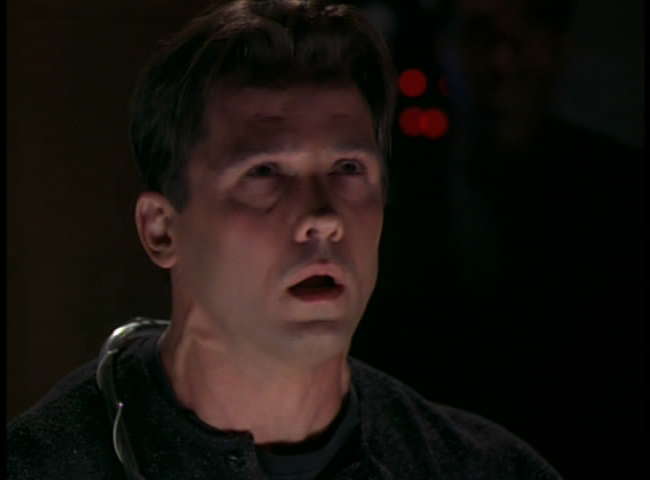
Overview: Here we have a movie with Bruce Campbell, Michael Dorn, and the very hawt Stephanie Romonov – this movie’s got to have something appealing, right? Um, not really. Menno’s Mind, a Showtime production is nowhere close to ready for prime time. The only thing worse than the acting and effects is the completely incoherent story. The FX are crappy low budget ones, but truly, nothing else in the movie even comes close to equaling them.
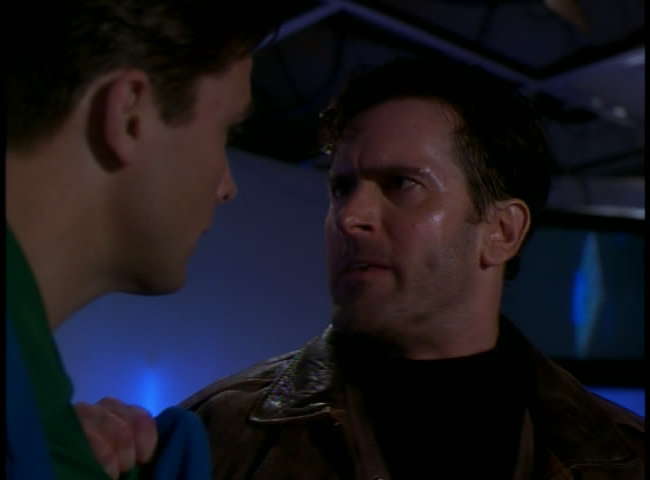
The Story: Menno’s mind takes place in a bizarre, cheesy future where everyone dresses in tacky bright clothes, except for the tough chicks, who wear black leather. Menno (The Rocketeer’s Bill Campbell) is a sappy computer programmer at a very popular virtual reality resort that provides people a choice of interesting vacations (most choose the virtual sex chick on the beach). The “System” that runs the VR vacations is very powerful, and has the capability to implant thoughts and suggestions into the vacationers. The resort’s head of security, Felix Medina (Corbin Bernsen), also happens to be running for President of the US (I shit you not…how far that office must have fallen for a head of security of a resort to be in the running!), and has decided to game the election by getting everyone who takes a vacation to be implanted with thoughts to vote for him in the election.
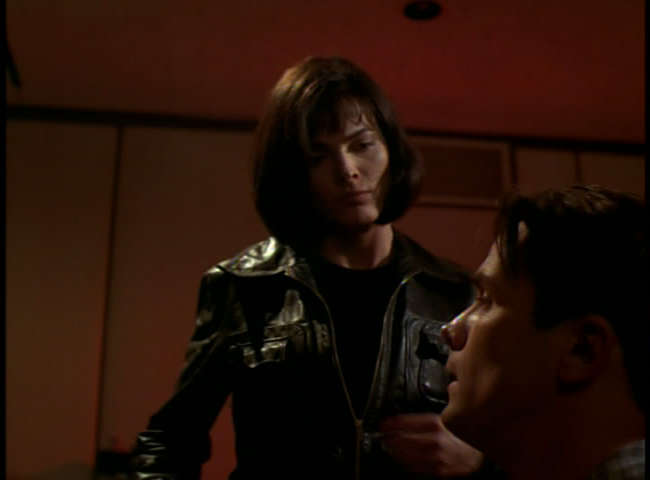
Luckily, disgruntled employee and rebel leader, Mick Dourif (Bruce Campbell), figures out the dastardly ploy and tries to stop it. Unfortunately, the bad guys have found him, and ambush his hideout. He barely escapes, goes to the VR resort, and forces Menno to upload his mind into the VR system before he dies! Yep, you heard it right, ladies and gents – although it wasn’t in the specs, apparently the VR system has the ability upload a human mind. Then things get interesting when Mick’s girlfriend, Loria, finds Menno and forces him to download Mick’s mind into himself in order to find out what Mick knew about the dastardly plot! From there, the race is on.
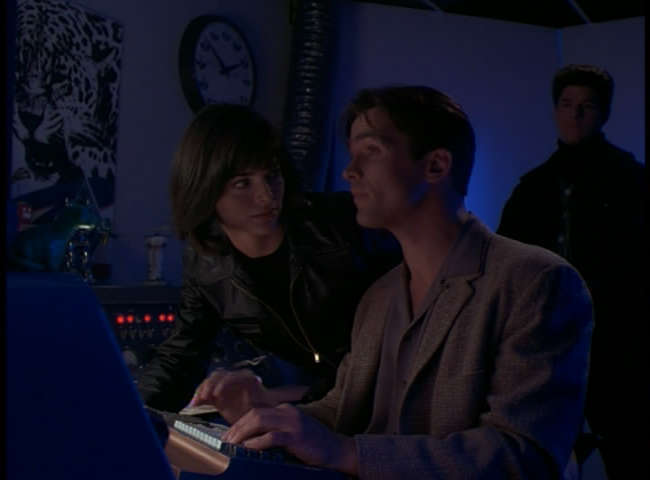
The Bottom Line: Truly, the number of problems and plot holes in this are almost uncountable. I’ll give it three stars because the production values are at least decent, but the story sucks more than words can describe. OK, so a security manager is running for President of the US – perhaps he should consider campaigning instead of trying to game a few hundred votes by convincing those who show up in the morning to vote for him – just a thought! I could go on, but the fairy science shown in this doesn’t even try to hold itself together. Worse, Bruce Campbell – really, the only reason I wanted to see this (I LOVE Army of Darkness!!!), dies early enough on that you barely get a chance to enjoy him.
~See movies similar to this one~
Movie Review By: SFAM
Year: 1999
Directed by: Scooter McCrae
Written by: Scooter McCrae
IMDB Reference
Degree of Cyberpunk Visuals: Low
Correlation to Cyberpunk Themes: Medium
Key Cast Members:
Ginny Chin-Chin: Jane Chase
Adrian Torque: Crawford James
Alik Silens: Alice Liu
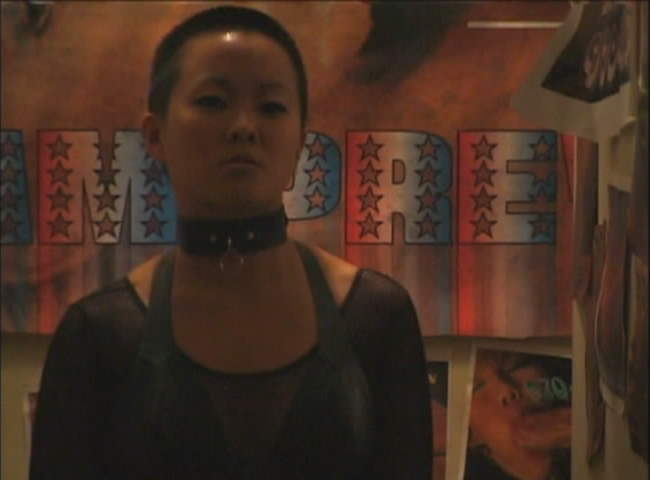
Overview: WTF!!! That pretty much sums up Sixteen Tongues. This low-budget softcore cyberpunk porn flick has potential in some of its thoughts, but just loses out in editing, movie making basics like clear dialogue and pointless filler scenes. Low budget flicks often free the director to stop paying attention to movie conventions and potentially create something unique. But to make this pay off, some of the basics of crafting still need to be worked.
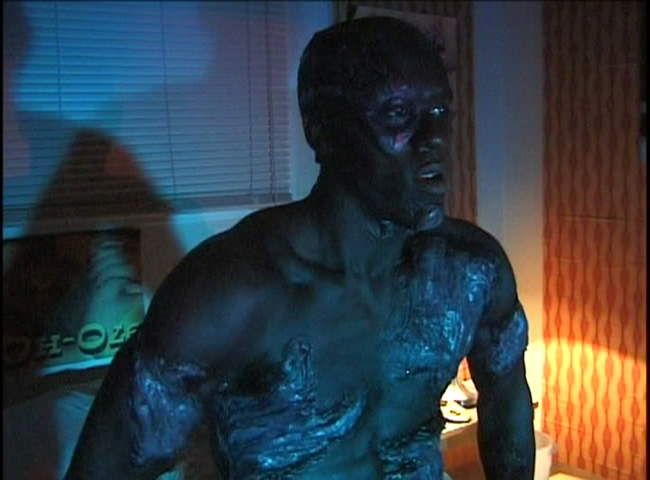
The Story: In a dystopic, seedy future, where humanity is fleeting, Sitxteen Tongues follows the plight of three emotionally scarred people (one physically scarred as well). Adrian (Crawford James) is a severely scarred police officer who seemingly died in a previous conflict, but was brought back to life, and had his damaged skin repaired by replacing it with sixteen tongues. His tongue skin, which forces him to taste his own clothes and everything he touches, has since made him go crazy – he hears voices and every now and then, and randomly goes on murderous rampages. Ginny Chin-Chin is a bio-modified assassin droid who has had sexual implants causing her to organism every time she blinks her eyes. The implants help her resist the urges to kill, but she still is driven to find her maker and rip him into shreds. Alik is a hacker extraordinaire, and is Ginny’s lover. She spends her time trying to find Ginny’s maker, but also has the ability to user her equipment to ghost-hack into other’s minds.
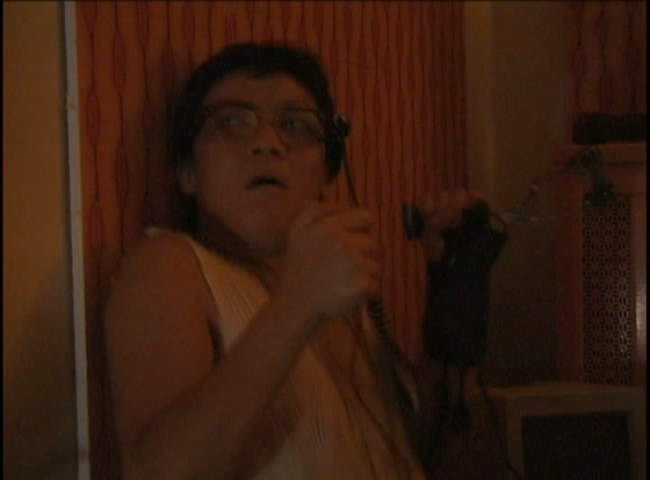
All three characters are emotionally traumatized. Alik and Ginny spend half the movie fighting about whether they really care for one another. Adrian is caught up in his own paranoid delusions. Through a chance encounter to get ice, Ginny and Adrian meet up. Ginny goes to his room (which has porno films playing non-stop) and finds out he’s a cop. She thinks he can help her in finding her maker, so she gives him oral favors in exchange for potentially helping her. While Ginny is having sex with Adrian, Alik hacks into Adrian’s TV signal and watches them. More arguments ensue.
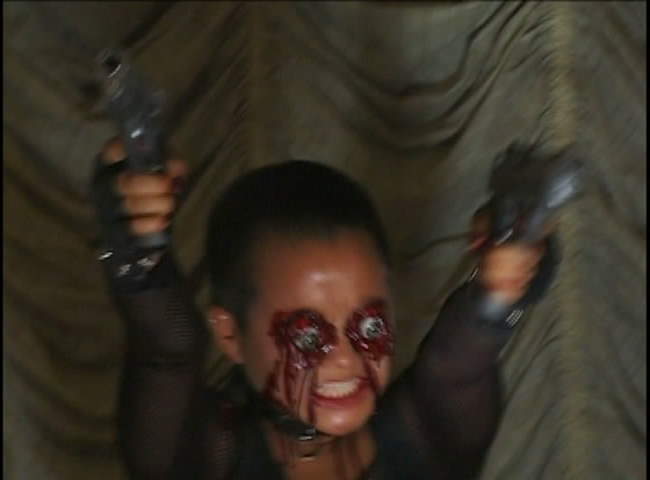
Eventually things come to a head due to Adrian’s paranoid delusions. In scanning Ginny’s bar-code, he knows she is a dangerous murderer, and for some reason, begins to think Ginny is actually responsible for his murderous rampages. Confrontations occur, and things spiral out of control from there.
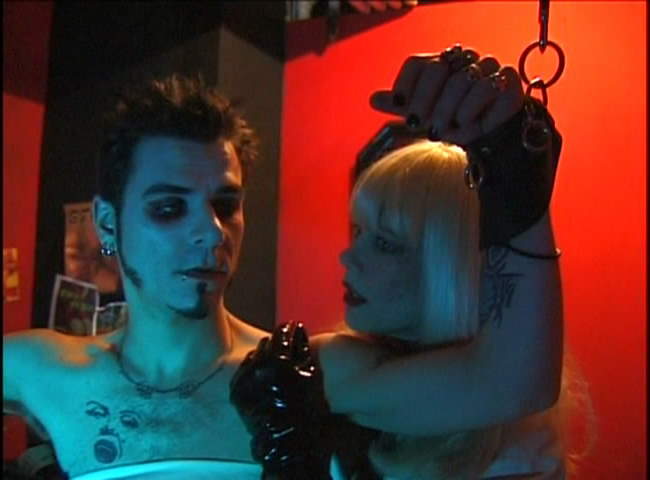
The Set: The entire movie takes place in a few rooms in a seedy hotel with porn posters covering all the walls. The hotels don’t look at all futuristic, aside for the credit card swap machines everywhere. They do at least look very seedy and lived in, although the random people sleeping on the floor was probably overkill. Also, we eventually learn that complete sexual deviants fill virtually every hotel room.
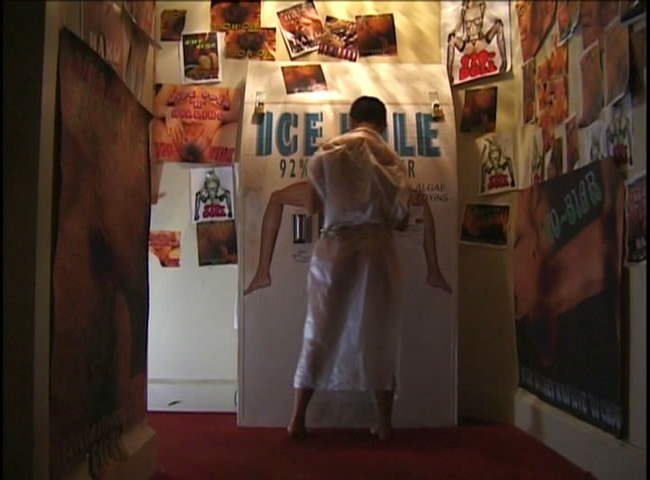
Picture slightly airbrushed out in obvious places. Go here for original.
The Nudity: Fair warning – Ginny Chin-Chin spends well over half the movie either in the buff, in a sheer shower-stall plastic outfit, or in her fishnet get-up. She definitely looks hawt in this, whereas Alik, also nude some of the time, is made to look as nerdy as possible. In addition, we are treated to other random nude chicks we see as the movie progresses. Blood and gore are also in high supply here.
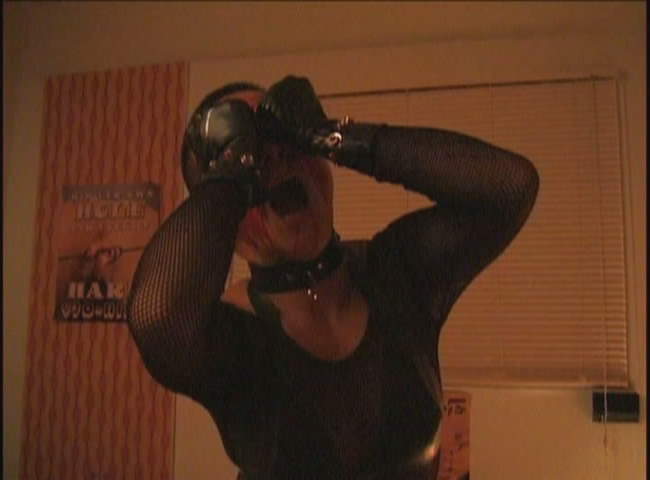
The Props: While at first glance, this movie borders on hard core by having an oral sex scene, if you look closely (or watch the extras), you can see that this is a prop. The dildo prop has various warts on it and spurts blood. Adrian’s facial skin grafts look pretty cool, and generally look like a part of him. Alik’s hacker tools, while extremely low-tech, at least pass some minor degree of believability.
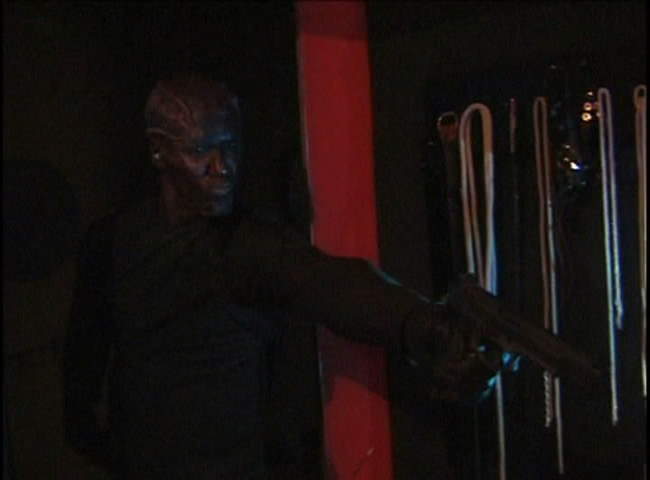
The Sound and Lighting: If there’s a place that Sixteen Tongues falls flat on it’s face, it’s the sound. The actors are clearly not that experienced, and tend to mumble their lines. Worse, McCrae, the director, doesn’t seem to mind. With this combination of poor quality sound reproduction and mumbled lines, the viewer is left to decipher the dialogue in many of the scenes by watching reactions. Adrian and Alik are the worst at this. There are a few scenes of each where the view has no possibility of figuring out what is said. The lighting is also atrocious. Constantly we get over-exposed actors or actors completely blotted out by a bright light behind them.
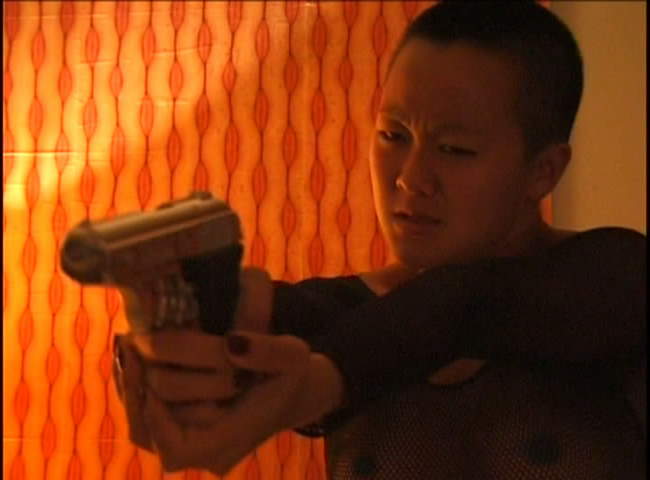
Picture slightly airbrushed out in obvious places. Go here for original
The Bottom Line: Some of the ideas with Sixteen Tongues are pretty interesting. The hacker approach is very similar in some ways to Neuromancer in that it really doesn’t seem to recognize a modern internet, but instead goes towards this almost inaccessible cyberspace that only specialized hackers can use. Unfortunately, some ideas, including the Android assassin bit, and the briefly mentioned bacteria-taking over the body and mind bit are barely even explain. While the plot is problematic and the acting sub-par, it’s the basics – lighting, editing and sound that really doom Sixteen Tongues. Again though, Jane Chase as Ginny Chin-Chin does look pretty smokin in her various get-ups. So if you want to see a bizarre, edgy, low-budget approach to cyberpunk with lots of nudity and gross scenes sprinkled throughout, you might get some enjoyment out of this.
~See movies similar to this one~
Movie Review By: SFAM
Year: 1998
IMDB Reference
Degree of Cyberpunk Visuals: High
Correlation to Cyberpunk Themes: Low
Key Cast Members:
J.B.: Lars Bom
Miauv: Puk Scharbau
Stoiss: Jørgen Kiil
Barbie: Karin Rørbeck
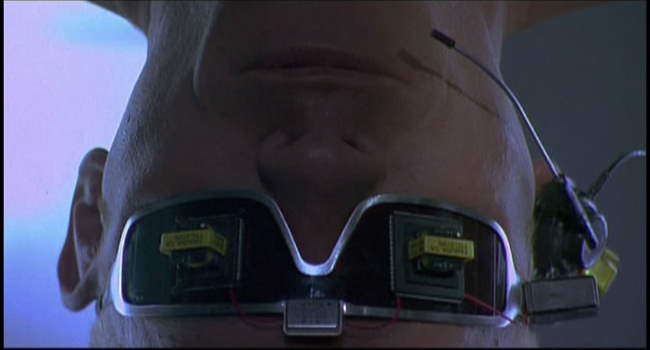
Overview: Yet another example of an ultra-buff weight-lifting zen super-hacker type who likes to log on almost naked while chicks watch him. In Webmaster (Skyggen is the original name), we get a story that shows the seedy underside of how to motivate network administrators when they fuck up and let a hacker in – just painfully force a multi-needle puncture device directly into their heart and give them a time limit to find the hacker before the device kills them! You might find this to be a short term solution, but I’m sure there’s a never-ending supply of good network administrators just waiting to take their place.
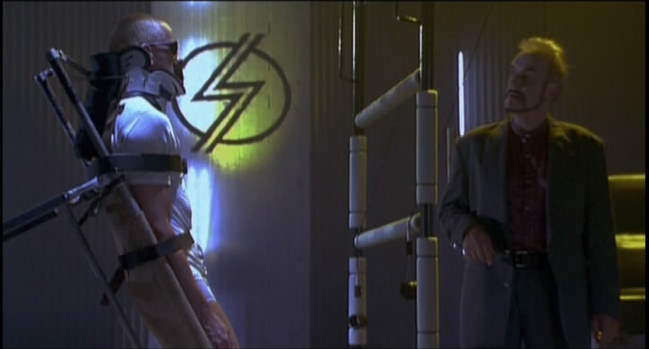
The Story: J.B. (Lars Bom) - an ultra-talented Webmaster of an illicit cyber-domain known for massive amounts of illegal money transfers is captured and is put under suspicion by the cyber-domain boss named Stoiss (Jørgen Kiil) when an intruder hacks into the system and steals the Stoiss’s money. Stoiss sticks a heart controller device on J.B. and gives him 35 hours to find who took his money or he dies. From this point, it becomes a straight, cheesy techno-thriller. J.B. and his girlfriend (Puk Scharbau) have to track down the hacker chick who’s caused the problems or else. While there were a few cool ideas early on, including highly powerful intelligent agents called “cyber-egos” that can be programmed to do all sorts of helper functions, unfortunately, these end up being peripheral to the story.
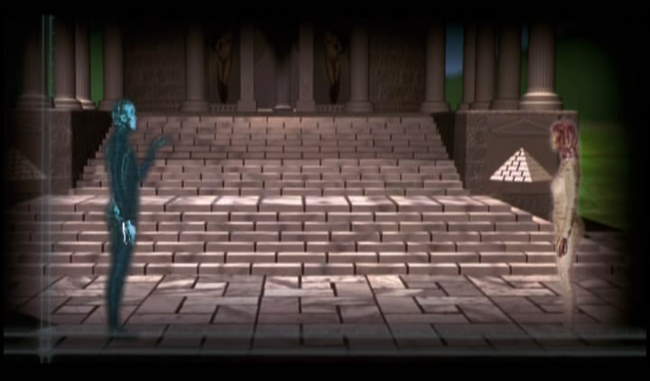
The Visuals: Webmaster seems to throw in lots of random visuals here, including a sexy black nylon S&M scene, strange dystopic surroundings and various other scenes. Unfortunately, for the most part these scenes don’t fit into the plot very well. Webmaster ’s FX are painfully bad. They would have been better off replicating VR by using real actors in a sleak, black room or something. Worse, we are told that Still, the glasses look cool, and there’s a fun Hannibal Lector shot. Some of the set pieces are decent, but overall, we get a cheesy looking unspecified cyberpunk environment.
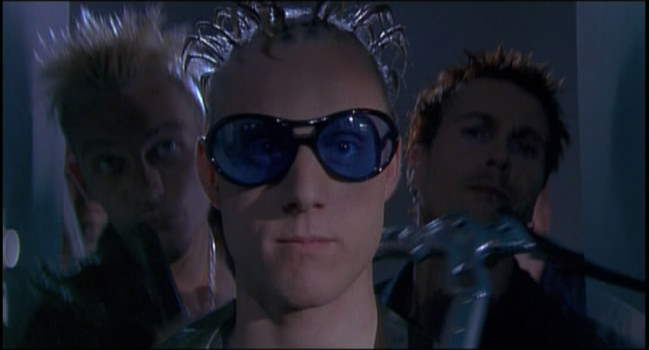
The Security: If it was written earlier, I might have thought that Skyggen written at a time when they thought most of us were completely uneducated where security issues were concerned. Webmaster has this incredibly bizarre multi-leveled security set up that can be completely bypassed if you get someone’s personal disc. Even weirder, supposedly, most of the transactions that take place involve illegal transfers of massive amounts of money. So, um, do the mafia dudes just send their address when they register in order for the site to send them their profile directly to their mafia hideout? Even worse, if the CEO doesn’t enter a special code each day, the entire system grinds to a halt. That’s the way to keep your customers – talk about a single point of failure! Even weirder – these discs which store your personal profile can be hacked into a written on! Worse, nobody apparently backs up their software, so if someone downloads your “ego-disc,” you lose it!
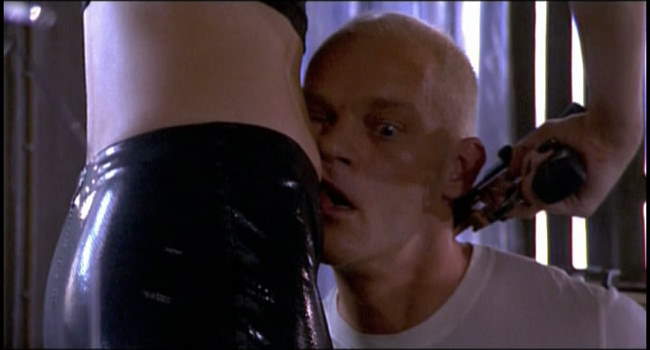
The Bottom Line: Unfortunately, the movie is in Danish, but my copy is dubbed in English – this review reflects this. However, I don’t know that it would matter much, as Skyggen is basically a low-quality, simplistic thriller with cyberpunk visuals for the wrapping. But even these lose their luster. Webmaster might have worked better if more attention was paid to the story, or the editing for that matter. Had it pursued some of the interesting VR themes it started off with better, this too might have helped. Instead, there are a stream lot of random scenes in Webmaster that have virtually nothing to do with the simplistic plot. Still, even though the effects are low quality, the cyberpunk visuals and hot chicks in black nylon may make it worth a watch for some.
~See movies similar to this one~
Movie Review By: SFAM
Year: 1998
Directed by: Neill Fearnley
Written by: Wynne McLaughlin
IMDB Reference
Degree of Cyberpunk Visuals: Low
Correlation to Cyberpunk Themes: Medium
Key Cast Members:
Johnny Dalton: Jeff Fahey
Nikki Holland: Tahnee Welch
Frank Donahue: Michael Ironside
Bosch: John Neville
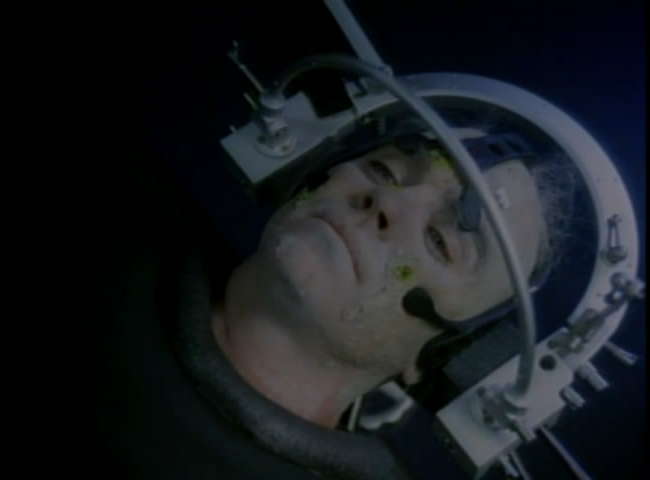
Overview: Some low-budget movies make it with a terrific story and just the right quality of effects; others come close; and others still get worried about not quite making it, so they decide to spew insane plot twists at the viewer in the hopes of increasing the tension. Unfortunately, Johnny 2.0 takes this tact. The movie was “teetering on the edge” of being decent, but fell off the wrong side. Instead of going with the stream of increasingly unbelievable plot twists, had they spent just a bit more on beefing up the story, Johnny 2.0 could have gotten some real kudos.
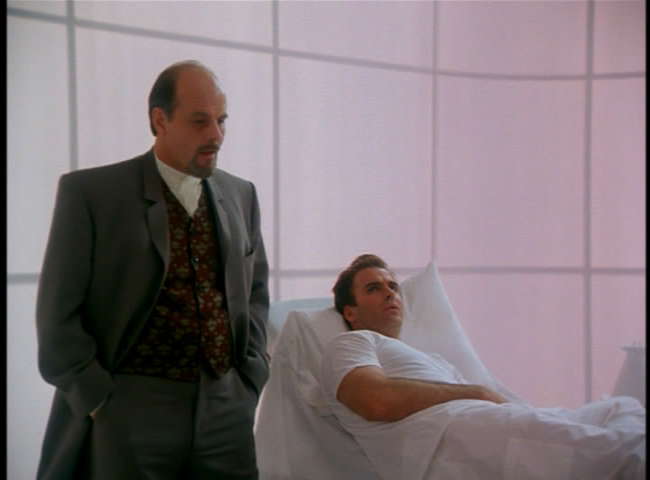
The Story: In the present, the experimentation with cloning begins to take off when scientist Johnny Dalton (Jeff Fahey) teams up with Frank Donahue (Michael Ironside) to create a small cloning start-up that has terrific potential. They are able to speed up the cloning process, and more surprisingly, are able to take an MRI scan of a person’s brain in a way that can record their entire set of memories. Unfortunately, anti-technology terrorists attack their complex and severely hurt Johnny, causing a massive, bleeding head injury.
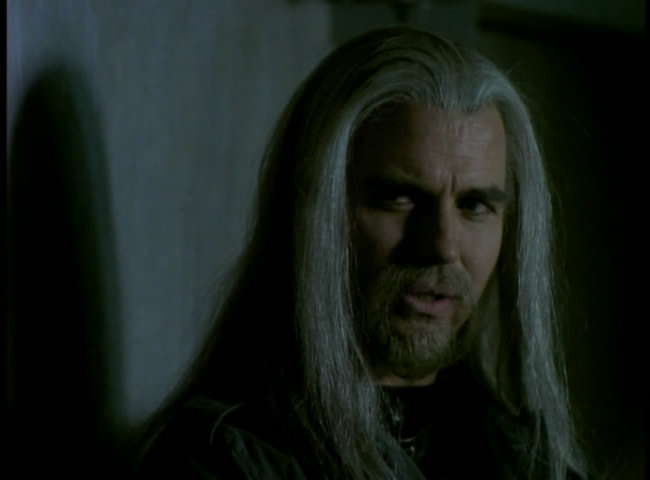
Johnny wakes up later to find that almost 20 years have passed, and that he is no longer Johnny Dalton – he’s a clone. Now referred to as “Johnny 2.0,” Johnny’s memories extend only to the injury 20 years ago when he had a scan of his memory. Now, the earth has become a dystopia, where countries have broken down, and only the corporations exist to maintain order. Worse, the “real” Johnny Dalton has either been taken by terrorists, or worse, has joined them, and has taken all his research, including a software program that removes imperfections in clones. Now, unless Johnny 2.0 can find and return the original Johnny Dalton, his body will start to break down within the week!
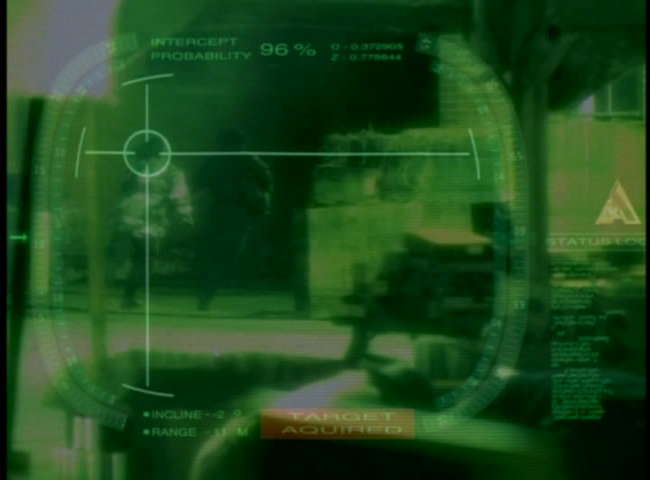
While the story starts off in an interesting way, and generally keeps a decent pacing, as things get tense, instead of resolving things in an innovative way, the viewer is continually assaulted with the most extreme plot twists. OK, one or maybe two might work, but Johnny 2.0 just doesn’t know when to leave well enough alone. Worse, in key scenes the rationale for certain characters starts to resemble the massive space invasion force surrounding Naboo in The Phantom Menace – they all seemingly took a lunch break when the counter attack came, leaving only one ship to defend their forces. When all is said and done, it’s simply not possible to suspend disbelief.
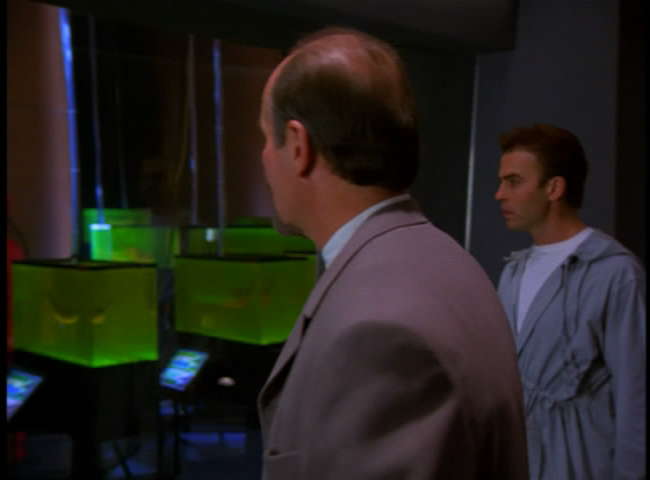
Johnny 2.0 Clone Technology Musings: For all its faults, Johnny 2.0 does have some interesting musings about cloning. The idea that clones can be sped up, and enhanced (by removing eye imperfections, improving the immune system, etc.) is interesting. More interesting is the idea that our memories can be recorded and re-inserted into a new host. Unfortunately, Johnny 2.0 doesn’t address idea with any degree of thought. In Johnny 2.0, the brain is essentially seen as an empty hard drive just waiting to be filled up with new memories. Even existing people apparently can have their memories wiped and re-inserted with new ones. Had this technology been combined with the rapid growth process, whereby a clone could be created while having their brain slowly become adapted to the imprinted memories, this would have worked lots better. Unfortunately, shortcomings in the ending narrative precluded anything unique here.
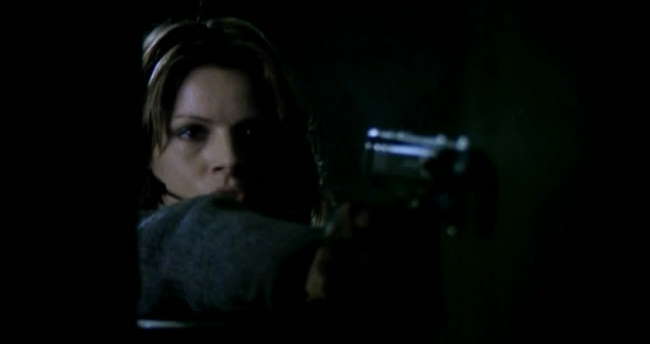
Even with the faults, Johnny 2.0 poses an interesting idea – that our existence could be perpetually extended by a combination of cloning and brain scanning. In Johnny 2.0, it’s the evil corporate head who is trying to cheat death, but if such a technology were created, one can only imagine the change we see in society. Imagine the chances we individually would take.
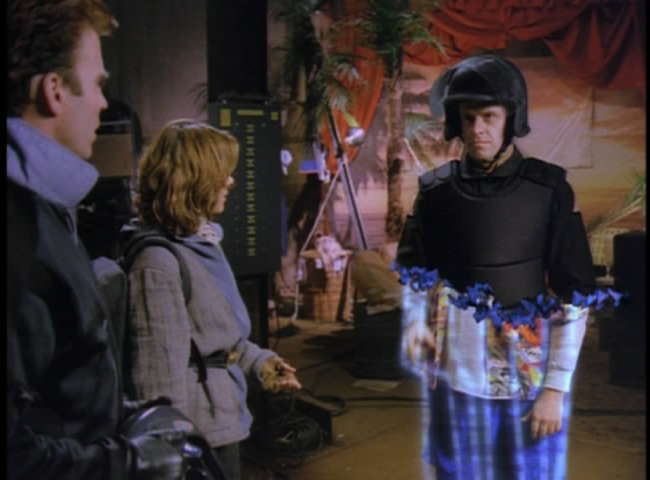
The FX: For the most part, the FX was what you’d expect – low budget TV fare. It wasn’t too distracting though, and pretty much worked for what was intended. Some of the effects, like the force field walkthrough scene was pretty forced though. One wonders why they would spend the money for a high-tech force field instead of a wall, especially when it can be penetrated so easily. They also seemed to try to stick VR helmets on everyone – this is more a sign of the times as VR stuff was hot in the mid nineties.
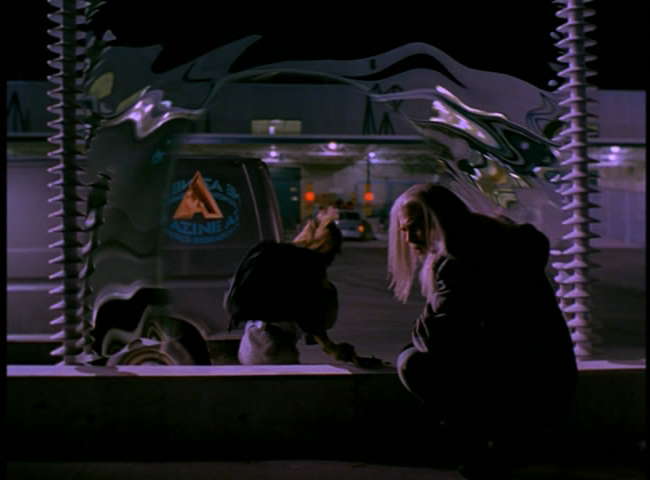
The Bottom Line: While the concept is interesting, this made for TV movie is poorly implemented. Although, there is enough here to get a modicum of enjoyment, and the movie does start off well enough that I feel compelled to give it at least a 5 star rating, especially considering it’s low budget. The actors were at least adequate (Michael Ironside of Total Recall fame was definitely the best of the bunch), so consider giving it a watch if nothing else strikes you.
~See movies similar to this one~
Movie Review By: SFAM
Year: 1999
Directed by: Chris Columbus
Written by: Isaac Asimov & Robert Silverberg (short story/Novel), Nicholas Kazan (Screenplay)
IMDB Reference
Degree of Cyberpunk Visuals: Low
Correlation to Cyberpunk Themes: Medium
Key Cast Members:
Andrew Martin: Robin Williams
Little Miss Amanda Martin/Portia Charney: Embeth Davidtz
‘Sir’ Richard Martin: Sam Neill
Rupert Burns: Oliver Platt
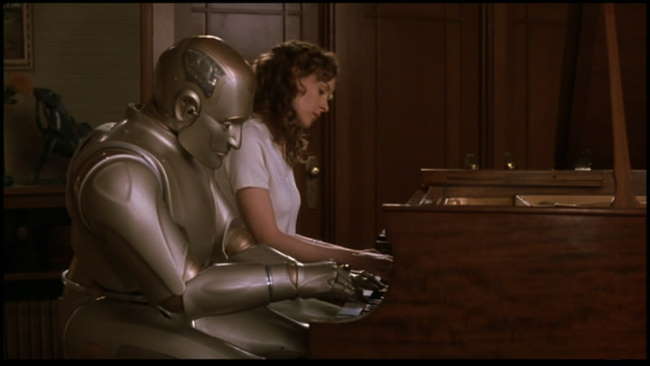
Overview: What a strange movie to try to categorize. Bicentennial Man seems like a Sci-Fi movie at times and a drama at others. In many ways, Bicentennial Man is hit or miss. Robin Williams and Embeth Davidtz are terrific, but the script itself really has trouble figuring out what movie this is going to be. Still, but there’s enough here to make it worth a viewing, as long as you don’t mind overly sappy movies.
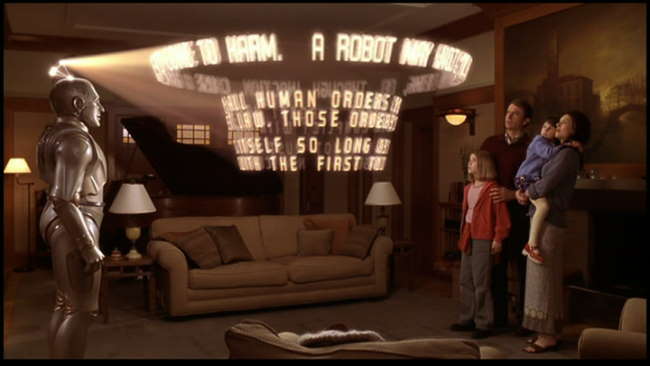
The Story: In the very recent past (2005 – but it was the near future in 1999), the Martin family has gotten a new appliance – a robot named Andrew. And while Andrew obeys the three laws of Robotics, and Andrew (Robin Williams) comes right out of the box with a sense of unexpected wonder. Andrew seems interested in all sorts of things that Robots aren’t normally interested in. In spending time with the youngest daughter, Little Miss (Embeth Davidtz), Andrew learns the meaning of love and humanity. Richard Martin, the father (Sam Neill) is intrigued by this and brings Andrew back to the corporation to talk about his “uniqueness.” The robotics maker is worried that this “bug” will ruin business and wants him terminated immediately. Luckily for Andrew, Richard likes his uniqueness, and decides to spend his time teaching Andrew everything a sentient person needs to know.
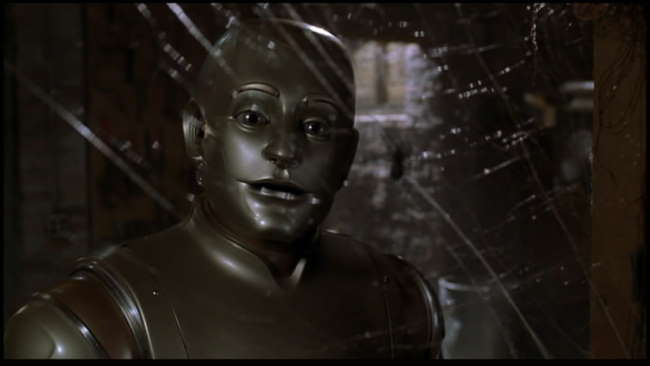
Andrew continues to grow and expand his capabilities and thinking. He becomes a master clock maker, and after working out the specifics of getting a bank account, makes millions in selling them. Time hurries on (well, not really – this part could have been edited somewhat) and Andrew’s family grows old and starts to die off. Andrew eventually asks and is granted his freedom, but still hangs around the family, especially Little Miss. He eventually goes in search of others like him, and then later finds ways of “upgrading” his appearance to become human-looking. It is at this point that he meets Little Miss’s grand daughter, Portia. He is captivated by her immediately, and begins to contemplate sharing the love with a human. But in order to do so, he decides he must be “declared” a human – this too will require change.
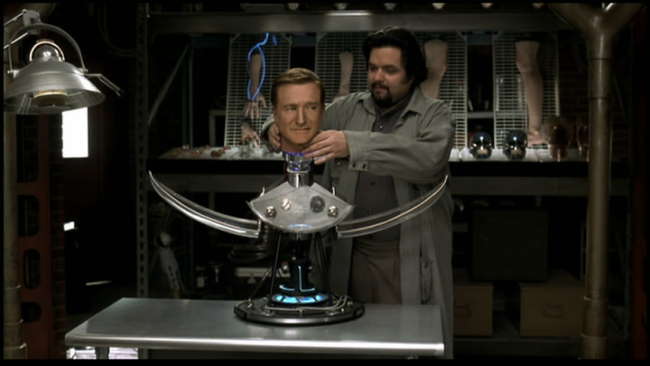
Is it cyberpunk? I was really torn about whether or not to include Bicentennial Man on this site. It clearly is not a cyberpunk movie in tone, in that the near future is closer to an idyllic situation than a dystopic one. We also don’t see a massive corporation controlling society. In fact, the story isn’t focused on society at all – it’s on an individual. So why include it in a cyberpunk site? Because of the post-human nature of the story Bicentennial Man presents us. Here we see an example of an android as a post-human versus a human transformed into a cyborg. The whole question of sentient androids and their quest for freedom and self-determination is raised and explored, although not to the extent I would have liked. In this Idyllic future, Androids are essentially still considered high-tech kitchen appliances. In its better moments, Bicentennial Man poses the question our society may face one day – when do we grant human rights to the products of our innovation? But again, I do fully appreciate that this move sits more in the gray area than it does as a cyberpunk flick.
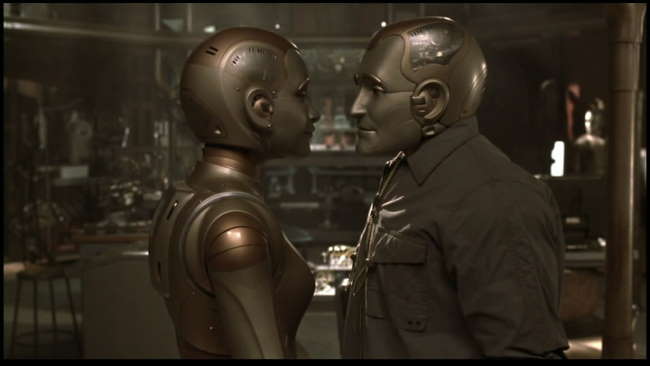
What defines humanity? One really wishes Bicentennial Man spent more time elaborating these questions instead of getting mired in a love story. While the love story was interesting and well done in an overly sappy sort of way, it is far less interesting than the question of what would make androids human. Here we have two androids – one clearly nothing more than a kitchen appliance, and the other something significantly more. Andrew has freewill, self-determination, is self-motivated, and clearly seems to “feel” love. Over time, he upgrades his body with the help of robotics tinkerer, Rupert Burns (Oliver Platt) so that he is human in virtually every way (can feel, have sex, etc.). In Bicentennial Man, Andrew pursues being declared “human” versus having human rights. Unfortunately, the movie glosses over how Andrew had the rights to maintain a bank account, own a house on the beach, or even a company. It’s clear that humanity encapsulates quite a few requirements – this movie focuses on our lack of immortality as a defining characteristic of humanity. While this may be true, it’s hardly complete. We are left with the idea that Andrew has all the other (unstated) traits but this one.
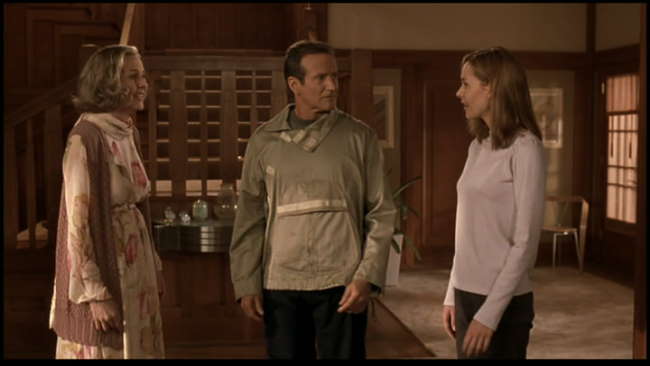
The Love Story: Bicentennial Man is a love story, and although it’s sappy, it’s still a complicated one. Andrew was really in love with Little Miss, but neither he nor her (who was also in love with him) were strong enough to admit it. Yet Andrew has another chance when her grand daughter, Portia, is an almost perfect image of Little Miss. Even then Andrew has trouble coming to terms with the possibilities. In the end, Andrew’s potential relationship with Portia represents his last step transforming to human.

The FX: While Andrew’s expressions are well done, clearly lots more could have been undertaken here. Every so often, we get glimpses of futuristic cityscapes, but unfortunately, these appear more tacked on than integrated. Throughout most of the story, which takes place over the course of 200 years, we see no interesting change in society. Literally, the technology doesn’t seem to affect life at all. This really is an almost unforgivable lack of thought and imagination. While there was scene after scene of little love and caring vignettes, futuristic visions were pretty much non-existent here – they could have easily been integrated.
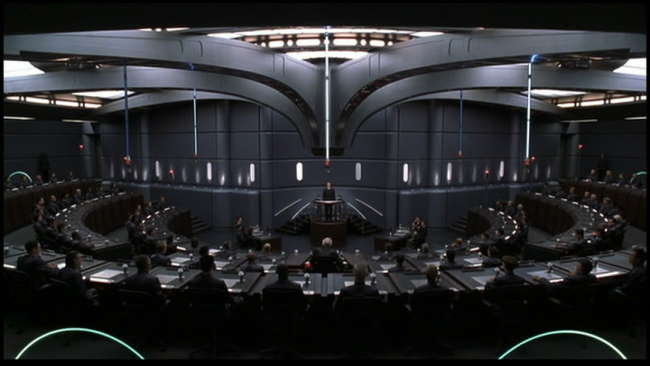
The Bottom Line: There is a number of problems with Bicentennial Man which detracts enjoyment. For starters, Andrew’s uniqueness is essentially magical, as no explanation is ever given. I would have hoped as Andrew became an inventor supreme of human and android cyborg parts, he would have spent time questioning his own existence and attempted to replicate it. Also, the length of time spent on Andrew with his family could probably have been edited down somewhat, and the time spent on the more interesting android questions and their effect on society could have been expanded. Still, there is enough here to make Bicentennial Man worth a watch. Williams and Davidtz have great chemistry and make the sappy love story work. And the questions posed are explored in at least enough detail to make you think.
~See movies similar to this one~
Movie Review By: SFAM
Year: 1991
Directed by: Shozin Fukui
Written by: Shozin Fukui
IMDB Reference
Degree of Cyberpunk Visuals: High
Correlation to Cyberpunk Themes: Medium
Key Cast Members:
Pinocchio 964: Hage Suzuki
Himiko: Onn Chan
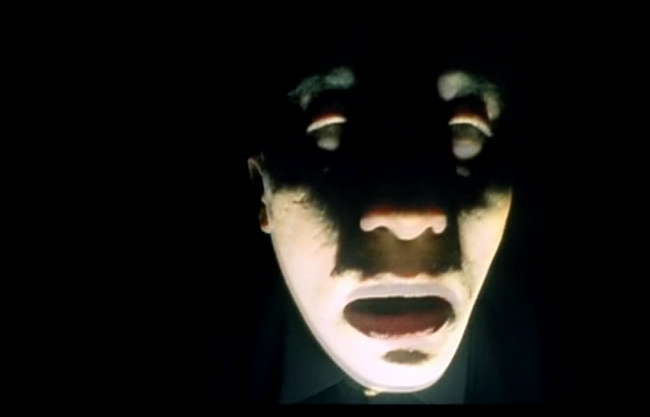
Overview: Back in 1991, Shozin Fukui and crew created a no-budget movie that provided yet another view of Japanese Cyberpunk, one very different from the first Japanese Cyberpunk movie, Tetsuo. In 964 Pinocchio, we don’t get an external merging of man and machine parts – instead, we see the residue of extreme internal struggles – ones that overwhelm the protagonists. The images are very intense, and the pacing is erratic and fast paced. While this movie is uneven and haphazard in places, 964 Pinocchio is definitely a unique experience.
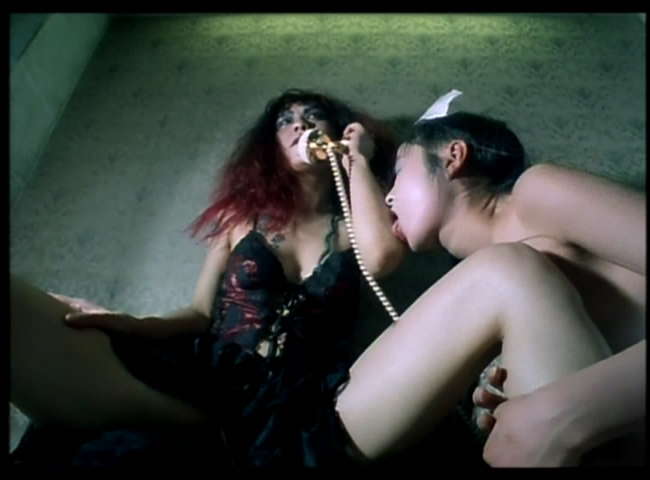
The Story: In this film, 964 Pinocchio (Hage Suzuki) is a strange type of cyborg – someone that used to be human but now has been transformed into a sex slave sold as product. Unfortunately, he no longer “functions” so his owners, a pair of sex-crazed, truly bizarre and sadistic chicks, have thrown him out in the street. Simultaneously, a nurse with a mysterious past, named Himiko (played by Onn Chan), has lost her memory, and she too has been evicted to the streets.

The two outcasts meet up and seem to have a strange attraction to one another. As 964 Pinocchio is essentially a child who seems to have little understanding or awareness of the external world, Himiko takes care of him. She takes him to her living quarters in the basement of a deserted building, and takes him on a food shopping spree where they steal and eat food in the grocery store. Himiko finds out that the corporation that produced Pinocchio is feverishly looking for him, as they are afraid that their illegal process for creating sex slaves will be made public.
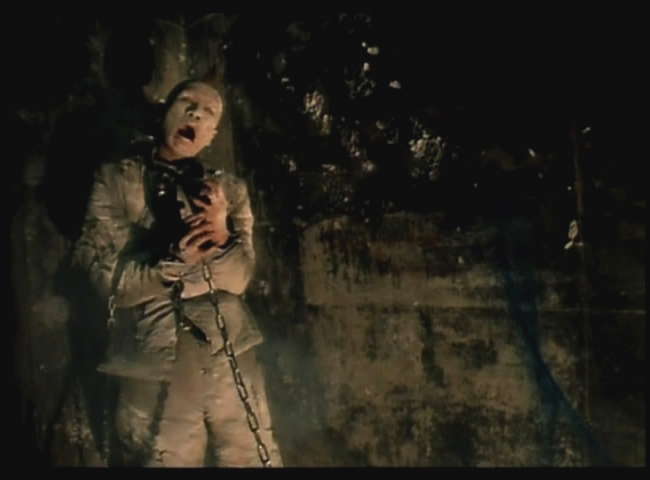
Eventually, 964 Pinocchio starts to gain awareness, and begins to wonder what has happened to him. After becoming frightened and agitated, Himiko calms him down, and then they both realize they have found a “like” soul and then make love (apparently 964 Pinocchio is able to perform when his feelings are re-engaged). Unfortunately, this event unleashes unseen forces inside of 964 Pinocchio – forces that are past the point of control. In short, all hell breaks lose – 964 Pinocchio begins spouting bodily fluids of all kinds and Himiko is thrown against the wall, and finally begins experiencing her own version of the horror. From there, the movie becomes a experiential voyage into the crazed and surreal. The corporation is still after 964 Pinocchio, but they soon discover he is not the same as he once was.
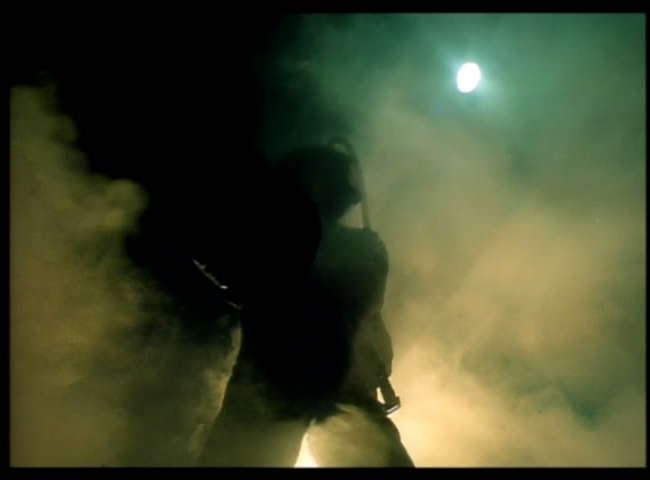
Rubber’s Lover is the Prequel to 964 Pinocchio: Even though it was created 5 years later, Fukia’s Rubber’s Lover is a sequel of sorts to 964 Pinocchio. In this film, we never really understand the process for how Pinocchio was created. Rubber’s Lover gives us a view of this. While the cover for the DVD describes 964 Pinocchio as an android, he’s really not. In fact, he’s virtually all human (although there is a drill to the forehead scene that shows brain matter being removed). If Rubber’s Lover is any guide, he was created by intense sound waves and special chemicals. So at one point he “was” human, but now is “post-human.”
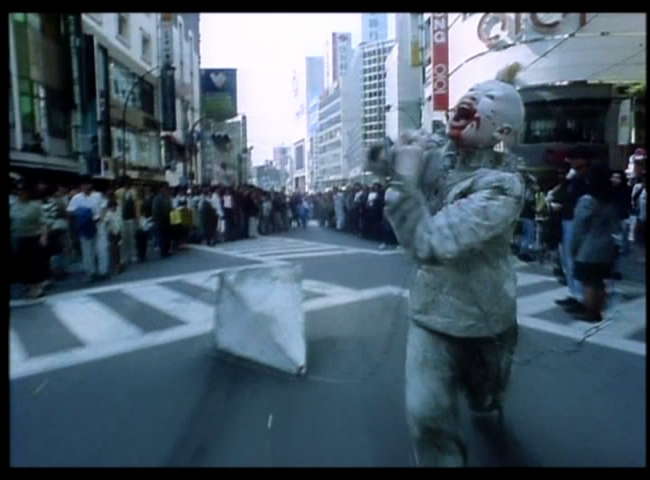
Note to Low Budget Japanese Cyberpunk Film Makers – Use B&W: Because of the low to no budget nature of 964 Pinocchio, the FX are not top quality. While they probably worked better prior to the CG world that we have today, similar to Videodrome, they look very dated in places now. This takes away from the impact of the movie to the point that it just doesn’t really work now unless you put it on a big screen and really crank up the sound. In comparing Tsukamoto’s Tetsuo (a B&W movie) to Tetsuo II: Bodyhammer (a color movie) and Fukui’s Rubber’s Lover (a B&W movie) to 964 Pinocchio, it’s clear that the mood, visuals and ambiance required for Japanese Cyberpunk is FAR better provided by B&W over color. In addition to both Tetsuo and Rubber’s Lover being better movies, they are both FAR more immersive. The low-budget B&W effects don’t detract from the mood, whereas in comparison the color effects look very fake. As an added benefit, shooting in B&W gives the film maker the a critical tool for cyberpunk mood setting: shadows. The use of shadows in a B&W film serve to create a dark, noir feeling which automatically serves up a non-normal mood.
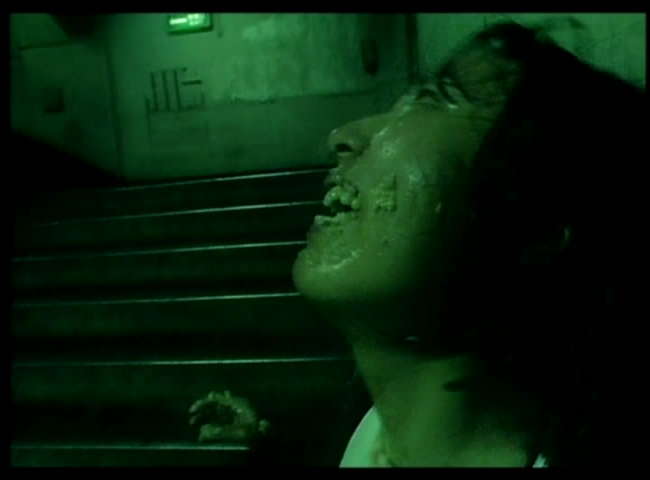
If You Have Vomit Fetish, 964 Pinocchio is For You! Fukui CLEARLY has a vomit fetish, and decides to share it with us in 964 Pinocchio. We’re not talking a wee bit’O vomit coming out - we’re talkin GALLONS worth! Himiko in particular vomits, wipes it on herself, wallows in it, and then eats it all back up! Yummy!
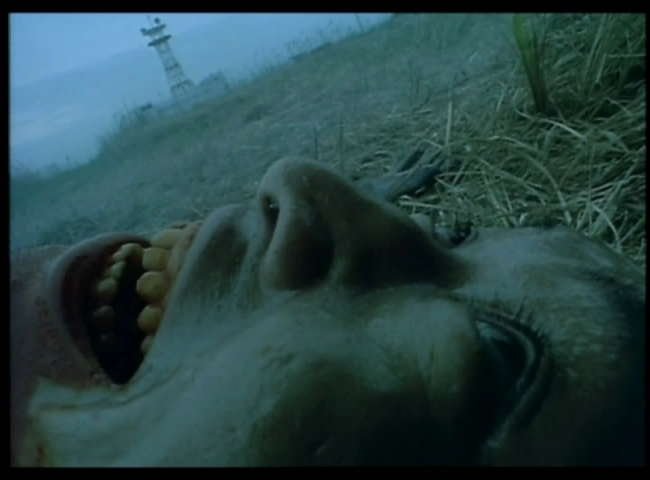
The Bottom Line: 964 Pinocchio is not polished fare, but it does etch out a place in the history of cyberpunk. The story is rather basic, and is really beside the point (many are left confused at the ending – page 2 gives a spoiler understanding if interested). The purpose is to create an immersive mood that details what happens when a dominant power emerges and exceeds human physical capacities. 964 Pinocchio is not for everyone – in fact it’s for a select few. If you aren’t a fan of extreme horror, gruesome imagery, constant screaming, jagged camera work and intense emotions, this movie is probably not for you. If you just want to see a Fukui film, you’re probably better off picking Rubber’s Lover. But if you want an instance of Japanese Cyberpunk in color – the first one in fact – 964 Pinocchio merits a watch.
Page 2: More Intense Screencaps and Spoiler Understanding of the Ending–>
~See movies similar to this one~
Movie Review By: SFAM
Year: 1993
Directed by: Sumiyoshi Furakawa
Written by: Yasushi Hirano (story), Kazumasa Hirai & Jirô Kuwata (characters)
IMDB Reference
Degree of Cyberpunk Visuals: Low
Correlation to Cyberpunk Themes: High
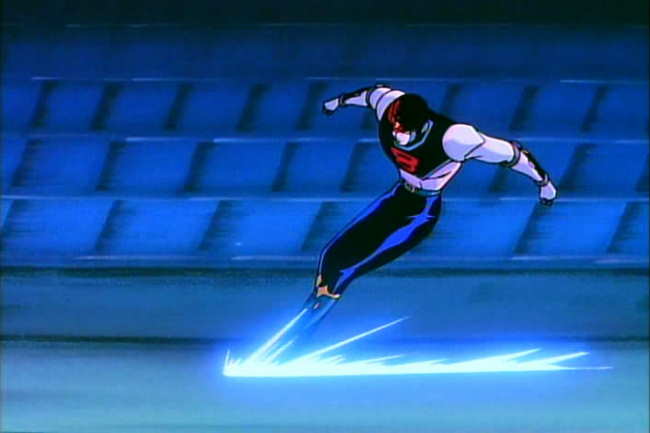
Overview: If you’re hankering for a sequel to Robocop, skip the live action sequels, and instead get 8 Man After. You won’t get the best animation, but the story itself is more than passable. The characters aren’t all that deep, but they’re interesting enough to keep your attention. This OVA, which on the DVD is presented as a film, seems to rise above the obviously meager animation budget to produce a decent product.
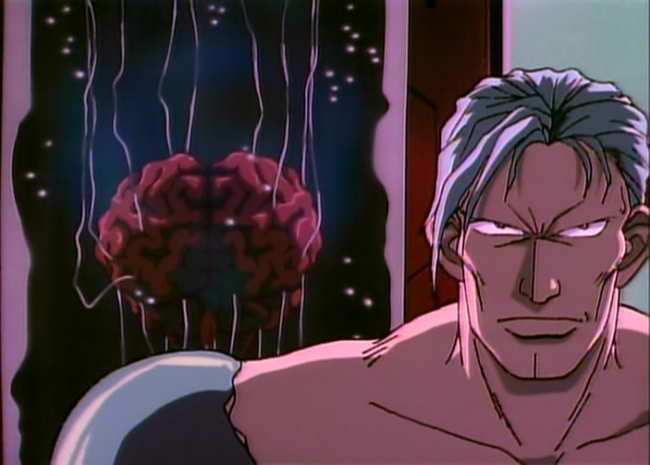
The Story: 8 Man After is a sequel to the 1960s TV series called 8th Man (I have not seen the original). In 8th Man, a cop dies, is revived, and is given a cybernetic body that can move lightning fast. He uses it to confront a cyborgs crime lord in similar circumstances, but is later killed. His girlfriend, Sachiko Yokogawa, never learns what happens to him. Since then, petty criminals with cybernetic implants have started to rule the streets. The police are outgunned, and decide they need a special edge – so they decide to revive the 8 Man.

In 8 Man After, a similar situation occurs as in the original – this time, police detective Hazama Itsuro, an emotionally fragile cop, meets up with Sachiko on a chance encounter, and they begin to fall in love. But fate intervenes, and a nasty criminal with cyborgs implants comes to kill them. Hazama is able to defeat him, but seemingly dies in the process by falling out of a high story window. Hazama is revived when the police take Hazama’s brain and insert it into 8 Man’s body.
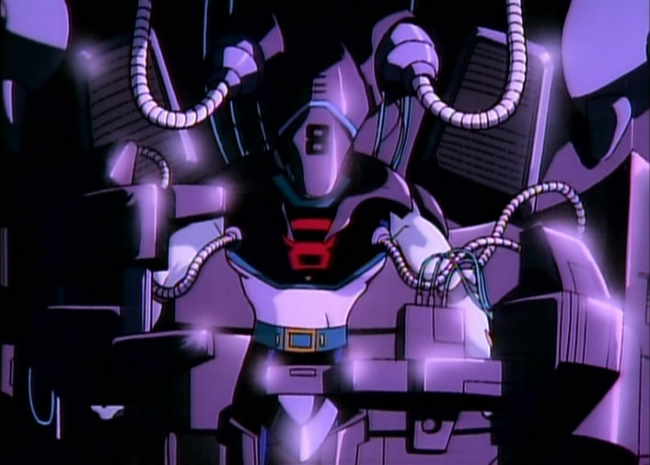
Hazama can now move lightning fast, and due to technical reasons, is the most advanced cyborgs on earth. He begins to fight the bad guys, but unfortunately, it turns out that his emotional troubles cause him to occasionally lose control over his actions. This is complicated by Hazama’s continuing relationship with Sachiko, who does not know what he’s become. Things come to a head when Hazama/8 Man goes up against the crime lord while trying to rescue Sachiko.
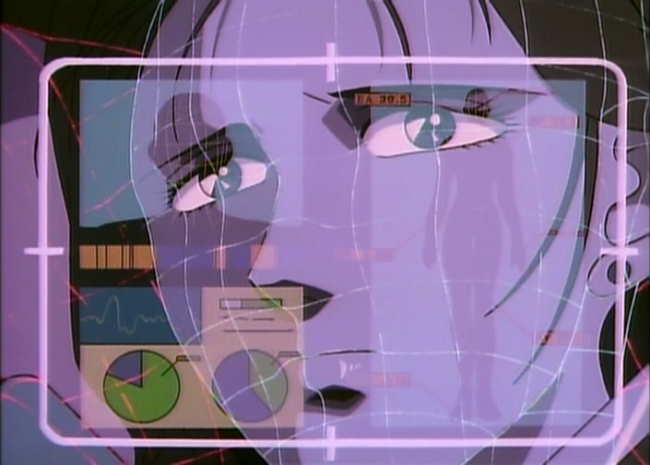
This is a “Who am I?” Story: 8 Man After does a decent job of going over established ground in that it questions whether a brain inserted into a cyborgs host is still human. The complicating twist in 8 Man’s case is that his emotions end up making him temporarily lose control over his body, and in fact, lose awareness over certain events. The added relationship aspect, where Sachiko has now fallen in love with two people who end up losing their bodies is sort of interesting as well. Again, there’s nothing really new here, but it is well done.
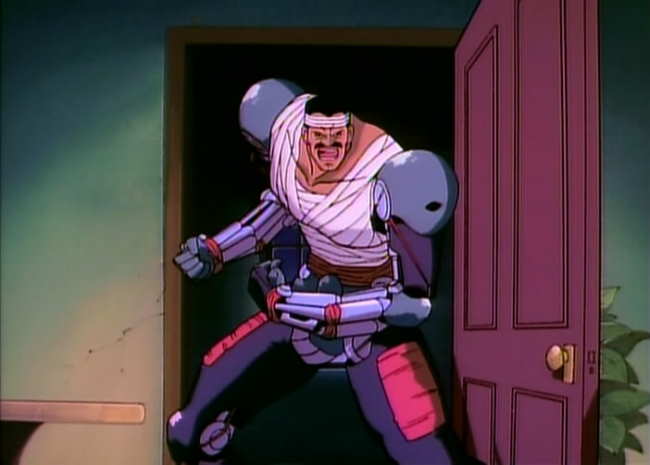
The Animation: At some level, animation of this quality, five years after Akira is surprising. Many of the shots look like straight Saturday morning cartoon fodder. Every now and then, we get a terrific shot or two, and sometimes get an innovating looking camera approach, but for the most part, you get simplistic backgrounds, very basic character designs, linear movement, and lots of pan and scans of stills. Worse, you also get some repeated 8 Man after streaking shots. Without an absolutely kickin story (which it has), 8 Man After just wouldn’t be worth the time.
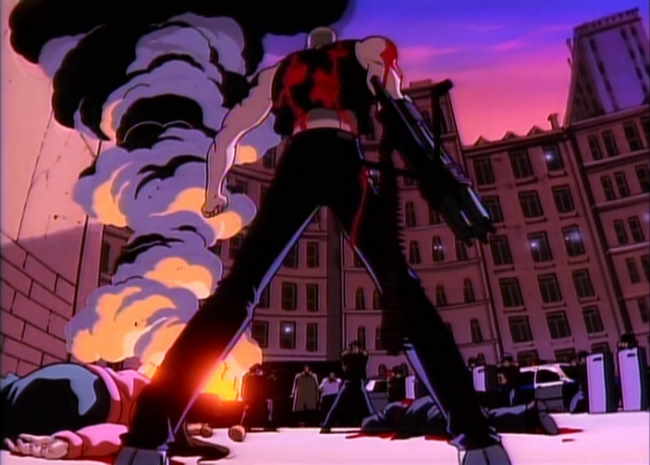
The Violence: Like Robocop, 8 Man After is very violent. However, the animation isn’t good enough for this to really matter all that much. There is lots of blood and killing which is usually don’t in the context of a motivating story, but it just doesn’t have the impact of many violent animes. Even if you can’t stomach violent story lines, you will probably be OK with 8 Man After.
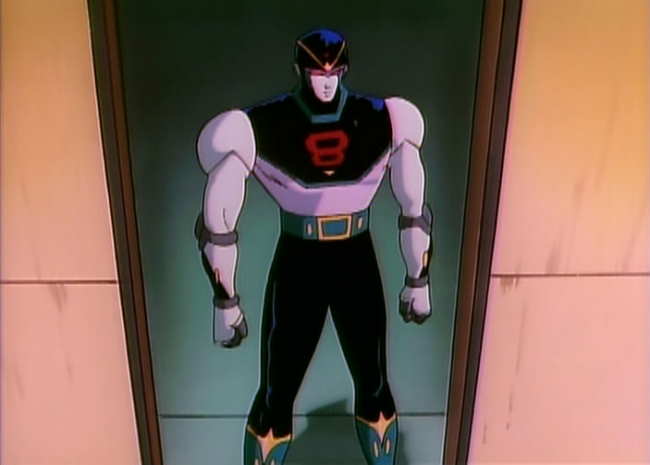
The Bottom Line: OK, the animation isn’t the greatest, but the story is pretty good – FAR better than the Robocop sequels. The sub-plot of the son with a burnt-out cyborg father is especially well done. If you’re looking for a Robocop-like examination of humanity, animated from the cyborg’s perspective, 8 Man After is a decent choice.
~See movies similar to this one~
Movie Review By: SFAM
Year: 1990
Directed by: Irvin Kershner
Written by: Frank Miller & Walon Green (screenplay), Michael Miner & Edward Neumeier (characters)
IMDB Reference
Degree of Cyberpunk Visuals: Medium
Correlation to Cyberpunk Themes: Low
Key Cast Members:
Robocop: Peter Weller
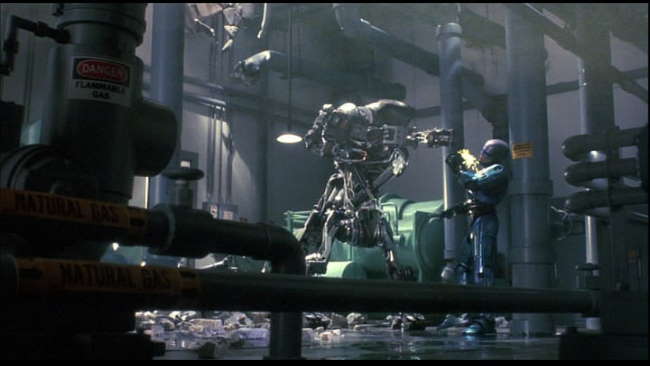
Overview: Oh how the mighty have fallen. In Robocop, we get a violent, satirical look at a future with an interesting story, complete with cyborg musings and incredible visuals. In Robocop 2, we get a tripe, over-the-top monstrosity that devolves into a Godzilla versus King Kong movie. Where Robocop provided a biting commentary on the state of corporate influence and advertising, Robocop 2 settles for a simplistically evil, nonsensical, corporate stooges who are far more interested in screwing society than they are making long term profit. Put simply, Robocop 2 is a mess when compared to its original.
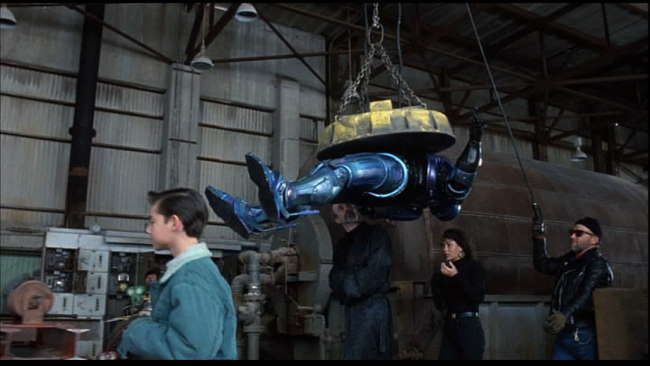
The Story: In Robocop 2, the OCP Corporation is bent on nefariously taking over ownership of the city so that it can squeeze every dollar out of the populace (which, interestingly, is already poor). As part of their plan, OCP tacitly supports the distribution of a new addictive drug called “Nuke.” With the cops on strike and the evil drug lord Cain distributing the drug and destroying the populace, only Robocop is there to protect Detroit from complete anarchy. But even Robocop is removed when a new scheming corporate businesswoman at OCP will do anything to get to the top, including screwing the CEO, ruining Robocop and replacing him with the Nuke drug lord, Cain. I could to into more details, but truly, the plot sucks too much to bother.
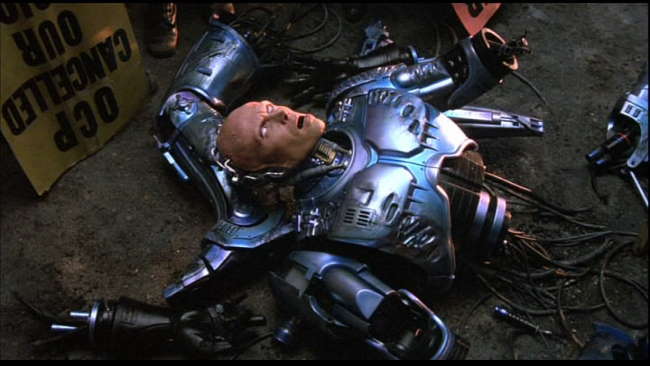
Robocop Stripped: “Christ, he’s been stripped,” is the line the policeman delivers upon seeing Robocop as a heap of parts. I couldn’t agree more. The plot points in Robocop 2 are idiotic at best. OK, so the bad guy and his 12 year-old kid beat Robocop. Of course, the logical thing to do is to drop him off, living parts and all at police HQ, right? And of course it makes sense for a Lawyer to control the Robocop project, even though there aren’t any legal issues involved. And just as logical is the corporation that gambles its entire viability on a psycho-maniac dead drug addict to be its corporate face and protector of the public, while destroying its investment in Robocop by programming him with silly parables (Gee, any reason they didn’t just re-assign Robocop to the military?). In topping this silliness, at least we know that Robocop, human brain and all, is able to easily withstand a drop from the top of a skyscraper. Interestingly, Robocop 2 tells us that the most expensive part of running a city is the police department, not the building of an ENTIRE NEW DOWNTOWN, which, we are told, will instantly pay for itself because its population will be paying for an addictive drug! I could go on, but clearly, the plot isn’t supposed to make sense. One wonders what the original script looked like as its pretty clear that Frank Miller’s script was modified significantly.
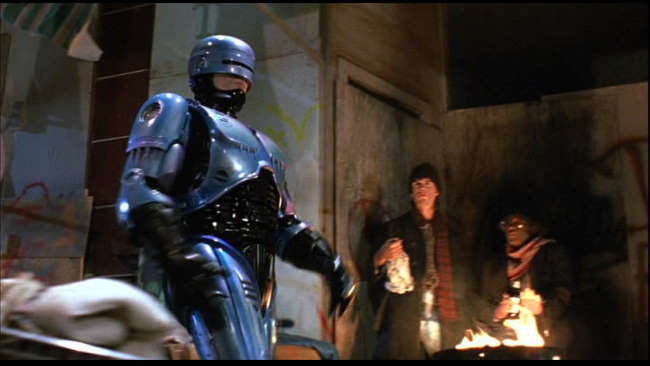
You can tell why OCP wants to steal Detriot to make money of the populace.
Detriot’s citizens are all millionaires!
The Bottom Line: While most of the key characters return (Peter Weller, Nancy Allen, Dan O’Herlihy, Felton Perry), they are joined by a cast that includes a parodied lunatic for a mayor (Willard Pugh), a kid for a bad guy (always the touch of death), and shallow scheming, horrible acting corporate bitch (Belinda Bauer). The interesting questions from the first movie are again posed, but this time in a sophomoric, absurd fashion – so much so that they divorce any interest in the potential answers. The FX, including the stop-motion animation are still decent enough to keep the movie from being a total waste, but just barely. If Robocop was intended as a total goof (meaning the actors realized this), it would have worked better. Instead, we get a story that qualifies as a parody while the actors seem to think they’re making a credible remake. The result is less than stellar.
~See movies similar to this one~
|






































































